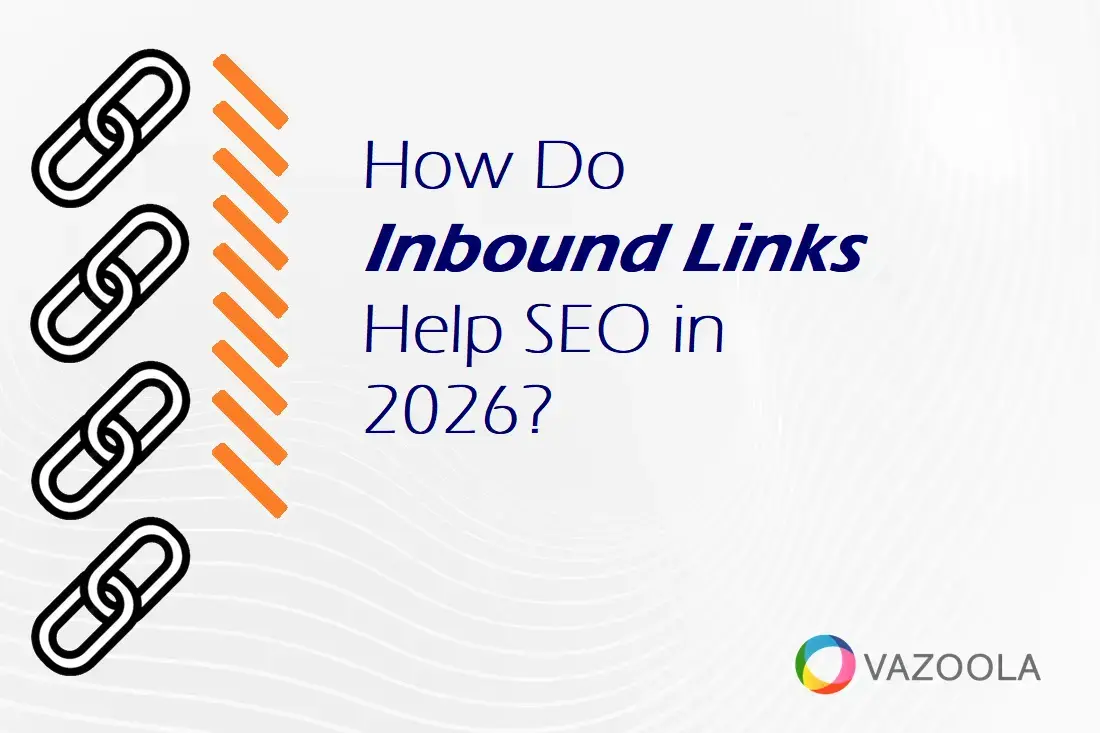How Do Inbound Links Help SEO in 2026?
Jul 01, 2025
Written by Casey Bjorkdahl

Casey Bjorkdahl is one of the pioneering thought leaders in the SEO community. In 2010, Casey co-founded Vazoola after working for a Digital Marketing Agency for five years in New York City. Vazoola is now one of the fastest growing and most widely recognized SEO marketing firms in the country.

What’s an inbound link, and how does it help you rank for search?
Search engines rely on many signals to rank content, but inbound links remain one of the most powerful. These links show that others trust your site—and that trust translates to higher search rankings.
Whether you’re a content creator, agency strategist, or business owner, understanding how to earn and manage inbound links is key to your long-term SEO success.
When used correctly, inbound links can drive authority, visibility, and organic growth. In this article, you’ll learn what incoming links are, why they matter, and how to use them to boost SEO in 2025.

Key Takeaways
-
Inbound links (also called backlinks) are links from other websites pointing to your own.
-
Search engines use inbound links to evaluate your authority and relevance.
-
High-quality inbound links from trusted sources improve your rankings more than large volumes of low-quality links.
-
Earning links takes strategy, strong content, and ongoing analysis—not shortcuts.
Table of Contents
What Is an Inbound Link?
What is the inbound links definition?
An inbound link is a hyperlink that points to your website from another website. If another business, blog, or media site references your content and links to it, that’s an inbound link. These links are important because they help search engines evaluate the credibility of your site.
Inbound links are different from internal and external links:
-
Internal links point to other pages within your own website. For example, this internal linking for SEO guide connects one page on the Vazoola site to another.
-
External links point from your website to a different website entirely.
Want to learn more? Explore Vazoola’s link-building guide for a deeper dive into strategy.

Inbound Link vs Backlinks: Is There a Difference?
Inbound links and backlinks are the same thing. Both terms refer to hyperlinks coming into your website from another site.
In the SEO industry, the two phrases are used interchangeably, though “backlink” is often more common in technical tools and analytics platforms.
No matter what you call them, the value remains the same: They help search engines assess the quality and relevance of your content based on who is linking to it.

Inbound Link vs Outbound Link
What’s the difference between SEO inbound and outbound links?
An inbound link directs traffic from someone else’s site to yours. An outbound link, on the other hand, directs your readers to another site. Both types of links matter for inbound links SEO, but they serve different purposes.
Outbound links help establish trust with your audience by referencing reputable sources. For example, here’s a helpful post about outbound links and their impact on SEO strategy.

Over-optimization of anchor text—especially with exact-match keywords—can raise red flags with Google. Track anchor variations pointing to each URL to ensure a natural mix of branded, generic, long-tail, and contextual anchors.
Why Do Inbound Links Matter?
SEO inbound links matter because they show search engines that your content is trusted and valuable.
When another website links to yours, it acts like a recommendation. The more of these recommendations you earn—especially from credible sources—the more authority your site builds in the eyes of search engines.
This matters because search engines are designed to surface the most relevant and reliable content. If trusted sites consistently point users to your pages, algorithms take that as a signal that your content is worth ranking higher.

Inbound links, especially from authoritative domains, help boost your site’s credibility and visibility in search engine results.
They also influence how real users perceive your content. When someone discovers your page through a link on a respected blog or media site, they’re more likely to trust what they’re reading. That trust can lead to higher engagement, longer time on page, and more conversions.
While not all backlinks carry equal weight, the right ones can move the needle significantly. That's why it's critical to focus on earning quality inbound links—not just quantity.
You can explore the full range of link types and their benefits in Vazoola’s guide to backlinks, which explains how each type impacts SEO. The same resource further outlines why quality links are more valuable than a high volume of low-authority ones.

A backlink from a high-authority site is good, but a backlink from a high-ranking page on that site is even better. Use tools like Ahrefs’ Top Pages or Semrush’s Organic Research to identify which URLs have SEO traction before pitching.
What Are the Types of Inbound Links?
Not all inbound links provide the same SEO value. Some carry more authority and relevance than others.
According to our research, there are at least 40 types of backlinks, but here are a few of the most impactful:
-
Editorial backlinks: Earned naturally when other websites link to your content.
-
Resource page links: Featured in directories or curated lists of helpful content.
-
Contextual links: Embedded in the body of a related blog or article.
-
Niche directories: Relevant, industry-specific listings.
-
Social media citations: Posts that link to your content and generate traffic.
You can find an extended list in our backlink types guide.

How Do You Get More Inbound Links?
How can you get inbound links to your website?
Remember, building inbound links isn’t just about asking for them. It requires a strategy that combines great content with smart outreach. Below are four tactics that work in 2025.
Create Valuable Content
Without a doubt, the top way to collect more links for your website is to create valuable content.
If you have high-quality content on your website, it will sell itself. The more often people visit your website, the larger your level of authority will grow.
Websites that have a lot of traffic naturally rank higher. If your website ranks higher, people are going to link to your website more often which leads to a positive feedback loop.
Publish high-quality content on a regular basis and the rest will take care of itself.

Backlinks placed in the top third of a page tend to have stronger SEO influence. When guest posting or earning editorial links, request placement in introductory paragraphs or near core insights rather than footnotes or author bios.
Network In Your Field
Of course, you may want to be more intentional about collecting high-quality backlinks. Therefore, you need to network with others in your field.
Where are your customers coming from?
You may want to speak with those professionals. Then, see if they would be willing to provide links back to your website.
If you network with other professionals in your industry, you will collect more backlinks.

Pair your best-performing pages with link-worthy topics in external blogs using automation. Tools like Pitchbox or BuzzStream can map prospecting lists against your own pillar pages for faster campaign deployment.
Create Infographics
There's a saying that a picture is worth a thousand words. That is why infographics are so important.
Everyone loves to link to infographics because they can collect all the information they need on a single screen.
If you create infographics on topics that people have questions about, people will link to those infographics. This will help you collect more quality backlinks.

Analyze the Competition
Who else is in your industry? Who is doing better than you? If you find inbound links from someone who is doing better than you, you need to see where they are getting their backlinks from.
If you can reach out to those professionals and convince them to link to your website instead, you will make inroads in your industry.
These are just a few of the top ways that you can collect high-quality backlinks that point back to your website. This can go a long way toward helping you increase your search results rankings by increasing your domain authority.
For more link-building methods, check out Vazoola’s guide to getting backlinks.

Find sites that link to your linkers. If a site published content that links to you, check which domains linked to their piece. Outreach to those second-tier sources with updated or expanded versions of the original content.
Are Inbound Links a Set-and-Forget Tactic?
Like any SEO strategy, link building requires regular monitoring. You need to know where your links are coming from, which ones are still active, and whether they help or hurt your site’s authority.
Some links may become broken or come from spammy domains. In those cases, it’s best to update or remove them using Google's Disavow Links Tool. If ignored, bad backlinks can negatively impact your search rankings.
Indeed, it’s essential to prune poor-quality links before they cause SEO damage.
We also recommend regular audits with inbound link checker tools like Ahrefs or SEMrush. Our guide to tracking inbound links breaks down the best platforms for staying on top of your link profile.
Our team at Vazoola specializes in building powerful, white-hat backlinks that boost search visibility and drive long-term growth. Whether you need editorial placements, outreach support, or a fully managed strategy, we’re here to help.
Book a demo today to start building links that move the needle.

A sudden spike in low-quality inbound links can signal a negative SEO attack. Use link velocity graphs in backlink tracking tools to spot anomalies early and proactively disavow before penalties occur.

